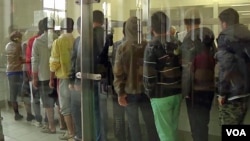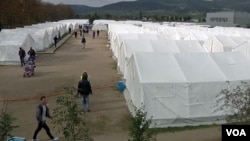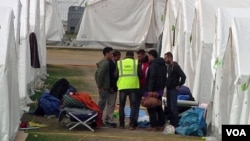Serving 2,600 people in a kitchen intended for no more than half that figure is a challenging task, but staff and management in Traiskirchen are slowly figuring out how to deal with the notoriously overcrowded camp.
Patience is key for those waiting in long lines that extend to the courtyard of Austria's biggest reception center for migrants and asylum-seekers.
One day, they were rewarded with a generous portion of chicken, rice and a side salad. The next day, the menu is going to change — although a big sign with a crossed-out pig indicates that pork is never on the menu.
“Asians like spicy food,” said Sam, a 28-year-old refugee from Pakistan who used to work at a pharmaceutical company. “They have no spicy food here. It's OK, but only to fill the belly,” he said.
Varied tastes
Walter Ruscher, the Interior Ministry's human rights coordinator for Traiskirchen, is aware of the complaints. Satisfying everyone's taste, especially considering the multiple ethnicities in Traiskirchen, is an impossible task.
But food has been low on the government's priority list. In July, when an unprecedented number of asylum-seekers reached Austria, about 4,600 people were living inside the reception center in Traiskirchen.
“We had to fight homelessness inside the reception center. There were people sleeping outside in the open. It was an unbearable situation,” Ruscher said.
Hundreds of children, women and men slept on the bare ground, unsheltered from heatwaves and rainstorms.
Since then, Traiskirchen has been the focus of outrage of local media and concerned citizens who believe that one of the world's wealthiest nations should treat better people in need.
Amnesty International, upon doing an inspection of the camp in August, called the conditions and treatment of the asylum-seekers "scandalous."
Slight improvements
Tents have been set up since, and no one is sleeping out in the open anymore, but Traiskirchen is still considered an eyesore.
Few news outlets have been granted access, and there's a general sentiment among local media that the government is hiding what's happening inside Traiskirchen.
But the Interior Ministry is trying to improve the image of Traiskirchen, and said that any media outlet asking for permission to access the facility would get an appointment for a supervised tour.
“We have made many improvements,” Ruscher said, pointing to the health facilities that are now staffed with two doctors, another facility staffed by the Red Cross and an ad hoc hospital with 40 beds.
Each new arrival gets toilet articles, as well as clothing and shoes. Baby carriages are available, young men play on soccer pitches and basketball courts.
There's also a beautifully decorated school with drawings of farm animals, and when children don't want to attend the voluntary classes, there's several playgrounds with swings and monkey bars.
Still, 2,629 people were housed at Traiskirchen earlier this week — about twice the capacity. The tent city with its 15 showers still houses 720 people.
The influx of migrants, most of them from the Middle East and Africa, has been overwhelming.
Asylym-seekers
In 2010, a total of 11,000 people sought asylum in Austria. In the first nine months of this year, the government registered 52,000.
By the end of the year, about 85,000 people are expected — roughly as many as in Germany, considering the relative size of each nation's population. The Germany, which has a population of about 80 million, has a land mass about four times larger than Austria, which has about 8 million residents.
“We can't control how many are seeking asylum. Last year, we'd have 50, or maybe up to 80 applications per day. This year, we have days with 500 applications and more,” Ruscher said.
Recently, the camp distributed electric radiant heaters, as nighttime temperatures have dipped to near freezing.
As a cluster of people quickly teemed around workers delivering the heaters inside the tent city, a security staff member assured migrants there would be enough heaters for each tent. "Just go inside the tents, we will bring them."
The tents are only a stop-gap solution in case all the bunks beds inside are taken, Ruscher said.
Permanent facilities
Over the next few weeks, once distribution to more permanent facilities in each province is better organized, the ministry hopes to be able to move all remaining asylum-seekers at Traiskirchen indoors.
But even if conditions have improved, opposition parties such as the Green party criticize the way Traiskirchen and other federal facilities are run.
Instead of having asylum-seekers' facilities run by the government or a nonprofit organization, such as Caritas, the largest relief organization in Austria, the task was handed to ORS, a private company.
ORS, a subsidiary of a Switzerland-based enterprise, won the contract to manage all federal asylum-seeker facilities with Austria’s Ministry of Interior — a total of 38, according to the ministry, up from just over 10 last year.
“A profit-oriented company will always focus on profits. The less money they spend on food and other services, the more profit is left for them,” Green party lawmaker Alev Korun said.
Ruscher, of the Interior Ministry, said NGOs had bid for the contract, but that the cost of running Traiskirchen and similar facilities would have been twice as high. In the taxpayers' interest, the government opted for the cheaper ORS.
While ORS said that they are doing their best to provide the best service and care, Ruscher said that it was also the government's duty to assure that there were no human rights violations, and that all refugees were receiving care in compliance with United Nations’ standards.
“That's why we are partners,” he said of the ORS.



